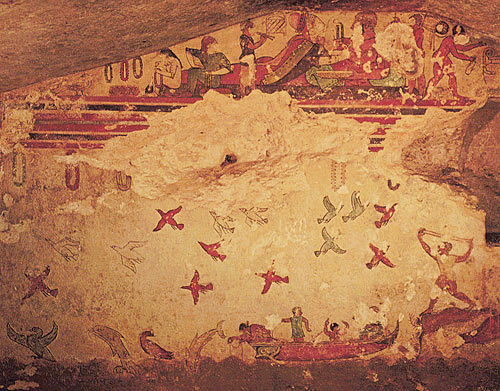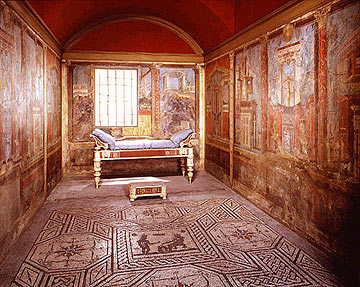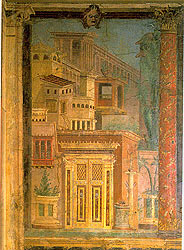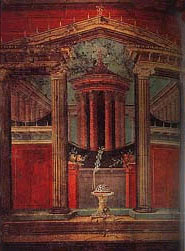
Tomb of Hunting and Fishing in Tarquinia, 6th Century B.C.
When looking back over the history of humankind, several prerequisites seem to have been necessary for a civilization to develop. There had to have been a transition from farming for subsistence by individual family groups, to a society where an important core would farm for the entire population, thereby allowing others to develop the social and political ideologies which would become the markers of their civilization. Out of these advancements came art, which has always been an indication that a culture existed and had reached the point where self-expression had become a possibility. It is very hard to sequester art into isolated categories which can stand alone -- because, like the people who create the art, influences of different cultures, places, and artistic individuality come together and create something that is a composite. The art of the Etruscans and the Romans may easily be used to show that art does not exist in a vacuum but has many influences both now and throughout the history of human life.
The Etruscans undoubtedly borrowed some of their artistic traditions from their ancestors, the Villanovans, but they had other influences as well.(1) Through their trading adventures, the Etruscans came into contact with many different cultures from the east, like the Phoenicians, and conducted business extensively with the Greeks. They took many elements of Greek art and made them their own, and the wall paintings of the Tarquinia tombs certainly give us a glimpse at their own finesse in the field. They may have borrowed Greek myths to use in their art, as in the Tomb of the Bulls, but they also created something culturally individual in their wall paintings.(2)
When looking at the sixth century B.C. wall painting from the Tomb of Hunting and Fishing(3) in Tarquinia, one can see activities taking place, not just static figures. The bright colours that the artist used seems to reinforce the authenticity of the painting and give it more movement. Birds are flying, fish are jumping and the ocean itself seems to have movement. Elements of nature are given a predominance in the wall painting, and boys are shown interacting with their surroundings. The boy with the slingshot has a realistic quality and it seems as if he will actually hit a bird when he fires a stone. The figure leaning over the boat seems to emit a genuine concentration with his task of catching a fish. There is also a boy climbing a rocky crag while his friend has already reached the apex and made a beautiful dive into the waters below. His body is perfectly aligned and one can imagine that these boys dived and climbed up again many times a day during the summers of their youth.

It would certainly seem as if these were boys from wealthy Etruscan families who had the luxury of having a childhood and being found in such a beautiful tomb seems to reinforce this notion. When people reach the point of death, or when they look back over their lives and reminisce, they often remember those golden days of childhood summers when everything seemed right with their world. Perhaps this is the significance of this wall painting. Maybe the owner of the tomb wanted those sweet days of his youth depicted, where he had fun with his friends and perhaps his brothers, and wanted those memories with him when he passed on to his next world.
Just as the Etruscans had been influenced by other cultures, they in turn had an effect on the art of the Romans.(4) The Romans took some of the aspects of Etruscan art and carried them a step further.(5) This can be seen clearly in the case of wall painting. The Romans decorated their tombs with paintings just as the Etruscans did, but the Romans took the art form into their homes -- in some cases, right into their bedrooms, so as to enjoy them in everyday life.(6) A fine example of the Second Pompeian Style was found in a bedroom of a home in Boscoreale, near Pompeii in 1900 A.D.(7) The villa had been owned by Publius Fannius Synistor, and dates to the mid-first century B.C. Like the Etruscans, the Romans were influenced by Greek artistic methods, but to a greater degree.(8) They greatly admired the Greek civilization as a whole and adopted many aspects of it for their own. One only has to think of the twelve Olympian gods, which the Romans integrated into their religion.(9) The same thing happened with art. August Mau had divided the Roman paintings found at Pompeii into four separate styles,(10) and it has been said that the first two styles "were outgrowths of Greek wall paintings."(11)
 | |
| Reconstructed bedroom, from the House of Publius Fannius Synistor Boscoreale, near Pompeii. Late 1st Century | |
 |
 |
| Detail | Detail |
| Room M of the Villa of P. Fannius Synistor at Boscoreale, buried by the eruption of Vesuvius in A.D. 79, functioned as a bedroom. The rear wall shows rocky terrain with balustrades and an arbor above, a small cave or grotto sheltering a fountain, and a small figure of Hekate below. In the center of the wall, between two columns, a parapet embellished with a yellow monochrome landscape supports a glass bowl filled with fruit. The side walls of the room are loosely symmetrical. Each wall is subdivided into four sections by a pilaster that defines the area of the couch and by two ornate columns. The paintings depict enclosed courtyards in which we glimpse the tops of statuary, rotundas, and pylons as well as vegetation. These precincts alternate with townscapes combining colonnaded buildings and projecting terraces. (Italicized Text and Images Courtesy of Metropolitan Museum of Art.) |
The bedroom looks like a room which has little wall space, but is full of window panels. The outside seems to have been brought right into the room by the use of paint and perspective. The master artist had painted the panels to look as if they were actual scenes that a person would see if looking out a window. Some of the paintings are very architectural in nature and depict groups of buildings that seem to recede into the distance. Balconies, porticoes, and even potted plants have been included for purposes of realism. Even a sanctuary of a goddess is shown to bring in a religious aspect. Numbers of beautifully decorated columns have been painted at intervals all around the room, and help to give an impression of depth, with the use of shadows.
Delicately painted birds surrounded by garlands of ivy and jutting rock give a definite feel of the outdoors, with an added touch of whimsy. A wooden garden arch stands at the top of the hill and gives a sense that something lies beneath it on the other side. The colour used for the sky seems very authentic and helps to give the sense of window viewing. All of the artwork is done in beautifully realistic colours, with Pompeian Red(12) giving cohesion to the entire room. This same colour is used on the ceiling to give an added sense of height to the room and actual depth to the individual panels. This depth:
... is achieved by axial perspective, in which all foreshortened lines of the building will meet on a central vertical axis (but not in one point). [It was] Greek geometricians and painters [who] had developed this system of "architectural perspective" and used it in stage backgrounds. To apply this type of painting to residential interiors was a Roman idea.(13)
It was this technique that gave these beautiful paintings their "illusionistic transparency."(14)
Even though the Tomb of Hunting and Fishing at Tarquinia came hundreds of years before the wall paintings of Boscoreale, both share some similarities. For instance, both pieces of art used the fresco method of painting on wet plaster, which helped to give them longevity.(15) Also the Etruscan penchant for dividing their paintings into sections had been passed on to the Romans(16) and is seen very clearly in the Boscoreale paintings. The genre of wall painting itself was Etruscan and was taken up by the Romans;(17) while both pieces have the influence of Greek art incorporated into them. Another clear similarity between them is the subject matter of nature, which is an important element of each. Both the Etruscans and the Romans were fascinated by nature and had made it an integral part of their art.(18) In this respect, both Etruscan and Roman art are very different from Greek, which does not depict nature at all or gives it only a secondary aspect.(19) And both cultures had upper classes who had the wealth to buy the luxury items they loved, and could surround themselves with beautiful artistic creations. This is seen in both cultures, especially in the Etruscan tombs and in the Roman homes which they used as showcases for their possessions.(20) Finally, both pieces used vibrant colours to express the artists' intention in portraying his subject matter.
There are also some differences besides the obvious one of age. The Tomb of Hunting and Fishing has little artistic perspective of depth, and is basically a flat representation of life. On the other hand, the style of the painting from the villa is known for its incredible artistic depth,(21) which is remarkable to us even today. The former functioned as enjoyment for the dead, while the latter surely gave joy to many people for many years.
Both of these paintings are very important survivals of the past. We may not be able to understand everything they depict, but they help to fill in gaps in the long history of art. These sorts of artifacts are also important because many believe that ancient people were somehow inferior when compared to us. When one sees the beautiful art that was created thousands of years ago, that is easily dispelled.
Related Papers
Ancient Athenian Women: A Look at Their Lives